• Top Causes of Truck Crashes
• Same licensing standards for all
• Road safety should include parking bays
• Deepening truck driver shortage crisis
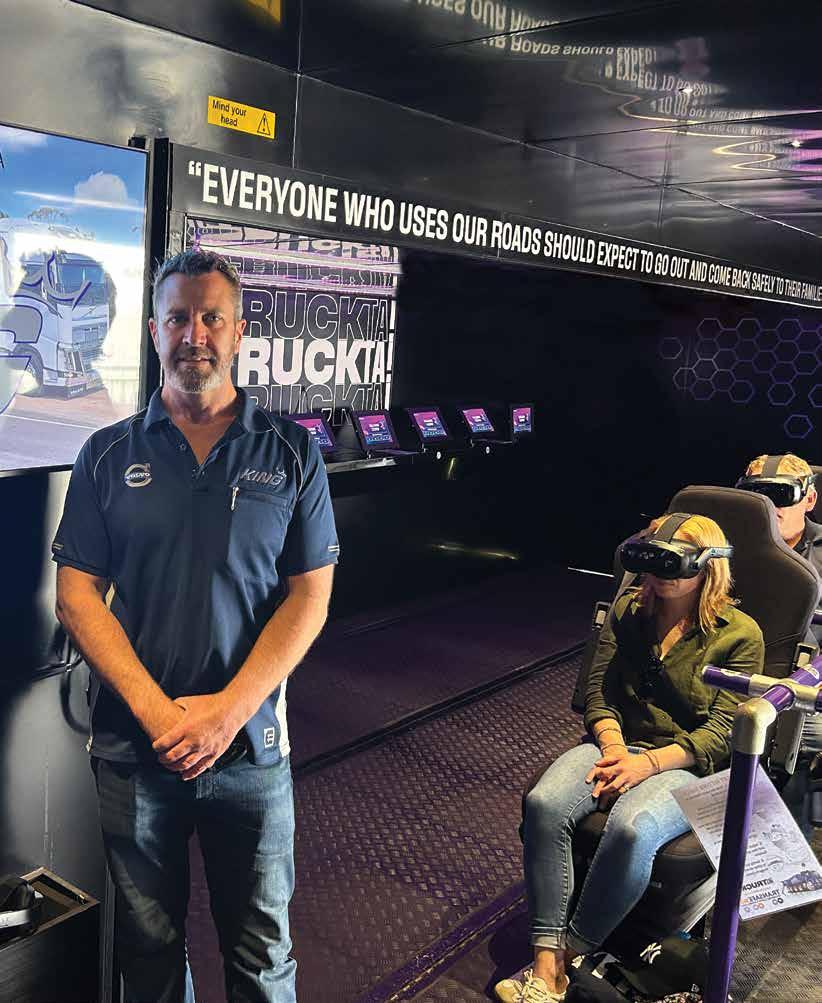

• Top Causes of Truck Crashes
• Same licensing standards for all
• Road safety should include parking bays
• Deepening truck driver shortage crisis

What began as one man’s visit to a field day has become a powerful story of change, showing how one person’s belief in the mission of sharing the

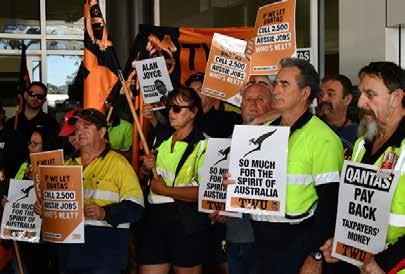

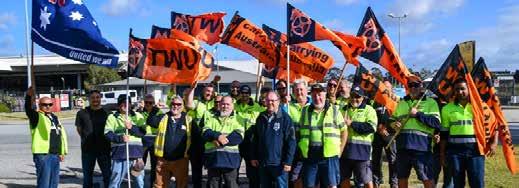


At the TWU, we are relentless in the pursuit of building and exercising worker power, guided by clear, strong principles. We are committed to earning and keeping our members’ trust and bargaining collectively. We aim to hold corporations to account, empowering the workforce with a strong and powerful voice.
The TWU has a number of Enterprise Agreements in a myriad of transport companies. If you work for a company that has an EA with the TWU, you, along with all transport workers benefit from the years of struggle and collective action of union members before you.

And set the standard for transport workers into the future.
TWU Members also benefit from a range of services available only to members
Legal Services
Wage increases and improved conditions through collective bargaining
Enforcement of your agreement and workplace rights
Representation for incidents or disciplinaries
Job Security and protection
$5,000 Funeral benefits
Free Wills
Extraordinary Driver’s License
Income Protection and Group Accident and Sickness cover
Collective purchasing power of UnionShopper to provide members with discounts on a range of restaurants, gift cards, white goods and more
You should be a member of your union, the TWU if you enjoy these benefits like:
Annual Leave
Maternity Leave
Long Service Leave
Sick days
Leave loading
Penalty rates
Superannuation
Health and safety and workers’ compensation
Allowances (meal allowances, shift allowances)
Rest breaks
Unfair dismissal protection
Becoming a member of the TWU ensures you can maintain these rights into the future.

The Heavy Vehicle Helpdesk is open from: 7am to 6pm Monday to Friday, and WA Public Holidays.
On weekends the Main Roads Customer Information Centre will receive telephone calls on behalf of the Heavy Vehicle Helpdesk on 138 HVO (138 486) and email enquiries can be sent to hvs@mainroads.wa.gov.au
Tel: 138 486 Fax: 9475 8455
Email: hvs@mainroads.wa.gov.au www.mainroads.wa.gov.au

When transport owner-driver
Russell King from King Logistics
WA stopped by iNSTRUCKTA! at the Dowerin Field Day, he expected nothing more than a quick look around. Instead, he walked away deeply moved and inspired to make a difference.
With decades of experience behind the wheel, Russell knew first-hand the challenges heavy vehicle drivers face on Western Australian roads — the risky overtakes, cutting in front of trucks, the blind spots, and the everyday misunderstandings between trucks and cars. But seeing iNSTRUCKTA! in action, TRANSAFE WA’s state-of-the-art road safety education truck, struck a powerful chord.
Inside the double expanding, custom built mobile classroom, school students, families and community members were discovering how to share the road safely by seeing things from a truck driver’s perspective. “This is exactly what’s needed,” Russell said. “If more people could see what we see out on the road, lives
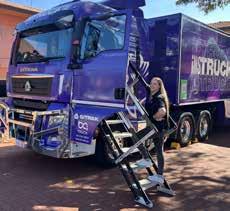
would be saved.”
Within weeks of that encounter, this passionate owner-operator took action. Out of his own pocket, he came forward to sponsor iNSTRUCKTA! to attend the entire eight days of the Perth Royal Show, ensuring thousands more Western Australians could experience iNSTRUCKTA! and its life-saving messages.
His generous support allowed TRANSAFE WA to reach the crowds, from city families
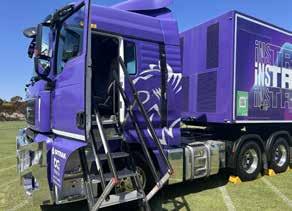
to country visitors and young drivers, with practical, hands-on insights into how to interact safely with trucks on the road.
Russell’s commitment didn’t stop there. He’s now encouraging others across the transport industry to get behind the initiative and help extend its reach. “We can’t just talk about safety,” he says. “We’ve got to invest in it. The more people who understand what it’s like from a truckie’s seat, the safer we all are.”

What began as one man’s visit to a field day has become a powerful story of change, showing how one person’s belief in the mission of sharing the road safely can create lasting impact. Thanks to Russell’s support, thousands more Western Australians are now seeing the road through a safer lens — and that’s a legacy every driver and every transport company can get behind. To learn more about how your organisation can join TRANSAFE WA as a valued Safety Partner and help make Western Australian roads safer for all, reach out to Executive Officer Rob Sharpe at www.transafewa.com.au
Together, we can drive lasting change.
If more people could see what we see out on the road, lives would be saved.”
~ Russell King, King Logistics WA


Angry Chicken Publishing Pty Ltd
Telephone 0430 153 273 www.angrychicken.com.au
ABN: 35 486 530 095
PUBLISHER / COMMISSIONING EDITOR
Karen-Maree’ Kaye
T: 0430 153 273
Email: karen@angrychicken.com.au
WRITERS
Karen-Maree' Kaye, Russell McKinnon
CONTRIBUTORS
Jan Cooper, Cam Dumesny, Cliff Graham, Carol Messenger, Ray Pratt
ADVERTISING ENQUIRIES
Angry Chicken Head Office
T: 0430 153 273
E: karen@angrychicken.com.au
DESIGN / PREPRESS
Cally Browning | Bare Creative
ACCOUNTS
T: 0430 153 273
E: accounts@angrychicken.com.au
PRINTER Daniels Printing Craftsmen
SUBSCRIPTIONS
Subscriptions available directly from the Publisher.
T: 0430 153 273
E: karen@angrychicken.com.au
Australia: 1 year $130 (inc GST)
Overseas subscribers: Airmail postage will be added to subscription rate.
Editorial Submissions: The Publisher welcomes editorial submissions. Once received they will become the property of the Publisher who reserves the right to edit the or adjust the content to fit with the format of our publication.
West Australian Transport Magazine (WATM) is published by Angry Chicken Publishing Pty Ltd
ABN: 35 486 530 095 All rights reserved. No part of this publication may be reproduced, adapted or transmitted in any form by any process (graphic, electronic, mechanical or storage and retrieval system) or sold, resold or otherwise exploited for any purpose without consent of the Publisher.
The publisher, contributors, editors and consultants disclaim any and all liability and responsibility to any person or party, be they a purchaser, reader, advertiser or consumer of this publication in regards to consequences and outcomes of anything done or omitted, or being in reliance whether partly or solely on the contents of this publication. No person, organization or party should rely on or on any way act upon any part of the contents of this magazine without first obtaining the advice of a fully qualified person. The Publisher shall have no responsibility for any action or omission by contributor, consultant, editor or related party for content within WATM. The opinions and content within WATM does not necessarily reflect those of the Publisher, editor or their agents. No responsibility is accepted for damage or loss of material supplied to the publisher.

fter the Federal Government released its 2035 emissions target, a 62-70 per cent reduction in Australia’s total emissions compared to 2005 and their Transport and infrastructure net zero roadmap and action plan there is being much said on the subject in relation to the transport industry in this edition.
The LRTAWA questions if Fuel Tax Credits will be a casualty of the race to Net Zero (Page 13) and makes the strong point that increasing the effective price of diesel will oversee a shift to alternatives ‘if’ they are available, but we are some way from reliable alternatives and what does it do to the investments industry has made in its fleet?
I thought it was heartwarming to see Owner Driver Russell King from King Logistics WA sponsor our very own
transport safety initiative iNSTRUCKTA! out of his own pocket to attend the entire eight days of the Perth Royal Show. Russell first saw the state-of-the-art road safety education truck, at the Dowerin Field Days and he expected nothing more than a quick look around. Instead, he walked away deeply moved and inspired to make a difference. (Front cover and Page 3). The difference iNSTRUCKTA! is making to how the public thinks about interacting with heavy vehicles on our roads is of immense importance and thank you to all the sponsors, organisers and volunteers.
As always, thank you to everyone who supports WA Transport Magazine.
Best,



7 Tipper Crt, Hazelmere WA
Office: (08) 9274 6355
Mobile: 0418 802 007
Rentals: 0488 003 228
Email: alan@haulmore.com.au
Website: www.haulmore.com.au



We have the following units currently in stock available for sale or hire:
Quad 4 Rows of 8 Full Axle Widening Low Loader with Hydraulic Suspension
Quad 4 Rows of 4 Full Axle Widening Low Loader with Hydraulic Suspension
Tri Axle Drop Deck Widener with Bi Fold Ramps
Dollys: 3x4 Low Loader Dolly – 2x8 Low Loader Dolly – 2x4 Low Loader Dolly
Side Tippers and Water Tankers
Flat Top Semi Trailers and Flat Top Extendables




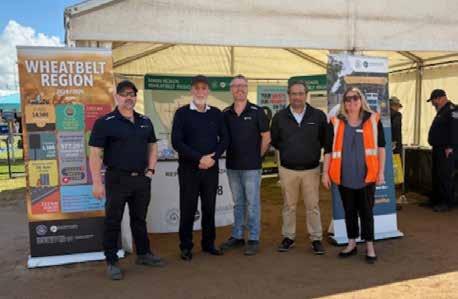
In August, Heavy Vehicle Services (HVS) partnered with the Wheatbelt Region to represent Main Roads at the Dowerin Machinery Field Days 2025 – one of WA’s largest and most iconic agricultural events. Now in its 60th year, the Field Days drew thousands of visitors to explore
innovations in farming, transport, and regional development.
Over the two days, the team spoke with approximately 300 attendees, many of whom arrived with specific questions. Topics ranged from the permit requirements for agricultural and oversize vehicles,
Over the two days, the team spoke with approximately 300 attendees, many of whom arrived with specific questions
pilot and agricultural pilot roles, vehicle standards and operating conditions, to route assessment applications and Restricted Access Vehicle (RAV) access upgrades, accreditation processes and compliance, and regional infrastructure projects.
HVS fielded several questions about the Traffic Escort Warden (TEW) role, including recruitment pathways, load width requirements, and pilot vehicles.
The representatives described the event as very worthwhile, with strong engagement and a wide variety of questions. Everybody who visited the booth left with useful information and a better understanding of heavy vehicle safety.
Anew report indicates a decline in the number of major heavy vehicle incidents attributed to inattention/ distraction and inappropriate speed.
The National Truck Accident Research Centre (NTARC) Major Incident Investigation Report 2025 shows decreases in two leading human factor-related incident causes from 2023 to 2024, with inattention/ distraction incidents reducing by 1.6% and inappropriate speed incidents by 7.6%.
Dr Jasmine Proud from Monash University’s Accident Research Centre said inattention/distraction, inadequate following distance, and inappropriate speed remain contributing factors and the focus of ongoing safety initiatives.
“Inattention/distraction accounted for 17.9% of all major incidents in 2024, a fall of 1.6% on the previous year. These are most commonly single-vehicle incidents, indicating this issue is one the transport industry is best placed to address,” Dr Proud said.
“Inadequate following distance was the second most common cause of human factor crashes in 2024, with 80% occurring
in major cities. These almost always involve another vehicle, often a car, emphasising the complexities of light and heavy vehicle interactions.
“We’ve also seen a decrease in the number of inappropriate speed-related incidents, which fell from 13.8% in 2019 to 8.6% of all losses in 2024. These incidents are not confined to high-speed roads and reveal how a heavy vehicle’s high centre of gravity, load shift potential, and articulation reduces its stability, especially on curves.”
NTI’s Chief Executive Officer Janelle Greene said the purpose of the NTARC report is to highlight opportunities where action can be taken to improve safety outcomes. This year’s report sees data further broken down to at a State and Territory level for the first time, allowing for more targeted action.
“Continuing to drive systemic and behavioural change remains central to reducing human factor related incidents and improving safety for all road users. Encouragingly, a range of industry-led and government-supported programs
are already targeting these issues, from tailored education and awareness campaigns to resource packs, toolbox talks and workshops, through to policy and technology innovations,” Ms Greene said.
“The research shows that heavy vehicle drivers have one of the most dangerous occupations in Australia. They face high levels of unpredictability in the workplace, including road conditions, environmental factors, and load mass and geometry.
In truck and car fatal crashes, heavy vehicles were not at fault in 85.7% of cases.
“The report has deliberately been released during October as Safe Work Month. Heavy vehicle drivers deserve a safe work environment free from the risk of death or serious injury.
Industry and government are working together to make change, and the NTARC Partnership is committed to continuing to support heavy vehicle road safety research to better understand the unique hazards of the sector and how they can be appropriately managed to better protect the drivers that keep Australia moving.”
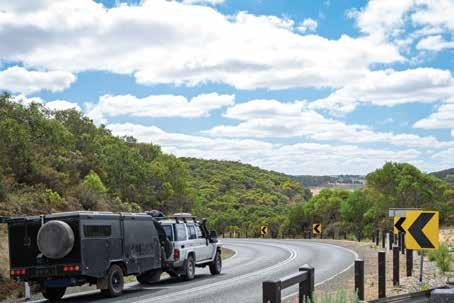
HVS was pleased to respond to a recent request from a business that hires out motor homes and camper vans. They were interested in having someone from HVS educate their staff on how to share the road safely with oversize vehicles, so that they could




and

and
Co-Browse Screenshare functionality
Our Heavy Vehicle Help Desk officers now have access to ‘CoBrowse’ Screenshare functionality. Co-Browse allows our Help Desk Team, when on a call with our customers and via secure access arrangements, to visually guide customers through our website to locate permit application templates, guidelines and operating conditions. Feedback on this functionality has been positive, and users have found it to be an effective and efficient tool. HVS Help Desk
pass this knowledge on to their customers.
A Road Transport Compliance representative duly visited their team to conduct an information session, and the feedback received was overwhelmingly positive.




From major truck workshops, heavy haulage, cranes, the mining industry and more… our team of knowledgeable and qualified technicians share over 100 years combined experience and focus on delivering prompt service alongside the supply of top name brakes and clutchesthroughout Australia and Asia.
With over 20 years in the industry we have a well-earned reputation for the development, manufacture and supply of quality standard and customised designs to suit a wide range of applications.
For the best advice and friendly service contact us today.
+61 8 9353 4411 ■ sales@knightbrakeandclutch.com.au knightbrakeandclutch.com.au




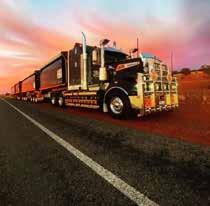


All truck drivers in Australia must meet the same licensing standards, a roundtable of multicultural drivers told the Australian Trucking Association this year.
ATA CEO Mathew Munro said the ATA had convened the roundtable to hear directly from multicultural drivers about their lived experience with the driver training and licensing system, as well as their day to day experiences on the road.
“The drivers at the roundtable had a combined total of 64 years of driving experience on Australian roads,” Mathew said.
a multicombination licence. At present, drivers just need to hold an HR or HC licence for a year to be eligible to be assessed for an MC licence.
“As a result of the feedback we received from the roundtable, the ATA is urging every state to adopt South Australia’s MC Licence Program,” Mathew said.
Mathew said the ATA’s other initiatives from the roundtable would include creating resources to help drivers understand sham contracting arrangements and report them and to develop an industry-wide charter
They welcomed the concept of moving to an hours-based system for progressing from a heavy combination to a multicombination licence
“They confirmed that multicultural drivers face wellbeing and safety issues including vile abuse on UHF radio and social media harassment, leading many to leave or contemplate leaving the industry,” he said.
The drivers also told the ATA that all drivers should be required to meet the same licensing standards. They said that overseas driving credentials higher than a car licence should not be recognised.
They welcomed the concept of moving to an hours-based system for progressing from a heavy combination to
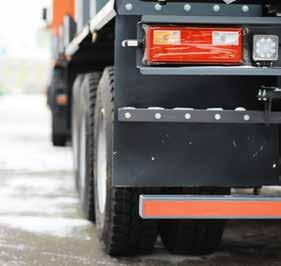
to help employers and the industry as a whole stand up to racist abuse.
“While the focus of the roundtable was multicultural drivers, their insights into driver licensing and training are vital for the safety of all,” he said.
The roundtable was sponsored by ATA Foundation Sponsors Volvo Trucks, bp, and NTI, as well as the ATA’s Diversity & Inclusion sponsor Teletrac Navman and the NHVR.
To read the full report visit new.truck.net. au/inroads-workforce
According to the Maritime Union of Australia WA Branch, 130 Grain terminal workers at CBH’s Kwinana facility were locked out for the second time in two months.
The company presented a proposed agreement which workers have described as a substandard and which was put to a democratic vote of the workforce. The result was that all but three individuals rejected it.
CBH locked out its workforce after sending a written counteroffer and bought in an alternative workforce.
“A number of issues remain in dispute, but the Union was working in good faith to resolve these differences through negotiation,” said Will Tracey, the WA Branch Secretary of the MUA.
The Kwinana terminal plays a critical role in processing this season’s record grain yield. The lockout jeopardises timely export and port operations.
The MUA points to CBH’s decision to lock out the workforce as being a major risk to the logistics of the bumper 2025 harvest.
The MUA makes clear that CBH workers remain ready to negotiate, but that requires CBH managers to return to the table with a genuine, fair offer.
Do not to rely on truck’s flashing right indicator as signal to pass
Industry bodies are urging motorists not to rely on a truck’s flashing right indicator as a signal that it’s safe to overtake.
The Australian Trucking Association has also urged truck drivers to stop using their turn lights like this, because of the potential for confusion.
ATA Chair Mark Parry issued the warning in a series of radio interviews saying, “There have been incidents where motorists have assumed that a blinking right hand turn signal on a truck meant that it was safe to overtake, only to find that the
truck driver was pulling out to go around an obstacle or was about to turn.”
“In addition to being dangerously ambiguous, using your turn lights to show that it’s safe to overtake is illegal.
“Under the road rules, you should only use your direction indicators when you’re required or as part of the vehicle’s hazard warning lights,” he said.
Mark said that motorists should only overtake trucks if they had a clear view of any approaching traffic and could see it was safe.
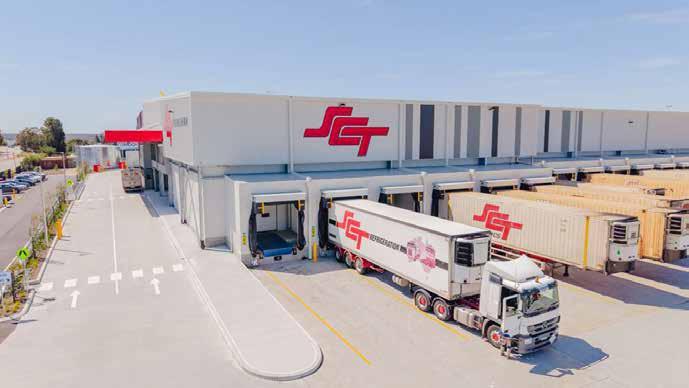
SCT Logistics has made a major investment in improving the security of the supply of goods to Western Australia through its $45 million investment into a new Temperature Controlled cross dock and storage facility at its site in Forrestfield.
Opened by the Deputy Premier and Minister for Transport, the Hon Rita Saffioti, the new facility will support Government objectives around improving supply chain resilience for Western Australia, and help ensure the State’s consumers are protected from the shortages in supermarkets and essential supplies such as those experienced in 2022.
“The new state of the art facility encompasses the arrival, dispatch and storage of refrigerated product by rail at its doorstep creating a buffer to future disruptions on the east-west rail corridor”, SCT’s Managing Director Geoff Smith highlighted. “It uses advanced logistics technology to respond to market demand, and ensure inventories cover potential future interruptions to freight supply”.
Deputy Premier Rita Saffioti underlined the contribution that the investment makes to the West Australian Government’s Supply Chain Strategy: “I want to congratulate SCT on their investment and delivery of this new facility. Our Government has been engaging closely with industry to build supply chain resilience and projects like this are critical to supporting multi-modal responsiveness
to supply chain disruptions.”
The Deputy Premier also focused on the support provided to more than 100 WA businesses which will access the new facility saying, “The Project will drive greater efficiency and cost-competitiveness for WA business, while its contribution to increased rail services will greatly enhance access to markets on the eastern seaboard”.
This Project continues to reflect SCT’s commitment to WA. Since commencing WA operations in 1975 and establishing the Forrestfield Intermodal Hub in 1999, the company has invested more than $500 million in infrastructure and dedicated rolling stock to service the West Australian market, transporting over five million tonne of freight across Australia each year.
“We supply around 40% of WA’s fast moving consumer goods into food and retail markets, and have grown to seven, 1.8 km-length rail services a week into
WA”, Mr. Smith emphasised. “This project will support a range of our long-term WA customers including major retail, manufacturing and primary production”.
The new investment will also bolster State and national decarbonisation efforts by making rail freight a more attractive option. “SCT’s activities equate to the removal of 73,000 truck movements through Perth and across the Nullarbor each year”, Mr Smith concluded. “This investment broadens the range of products that can be viably transported on rail, and is a crucial part of the company’s long term commitment to West Australia”.
SCT Logistics was established in 1974 by Mr Peter Smith, and is now a national, multi-modal transport and logistics company which has branches throughout Australia, with offices in every major capital city and regional locations in Victoria, Queensland and NSW.
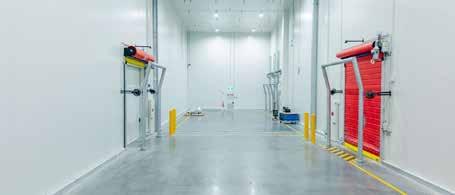
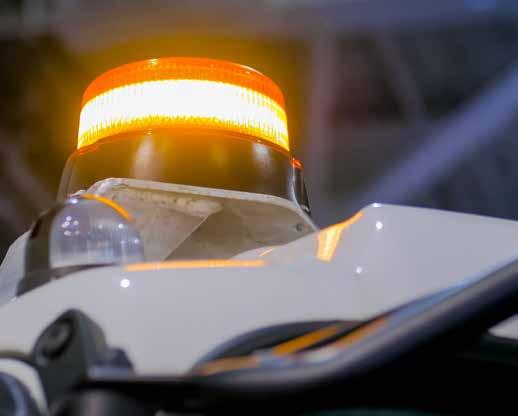
After many years of driving trucks across Western Australia, I thought I’d seen it all. But a recent run along the Great Northern Highway from Perth to Wubin proved me wrong – and not in a good way.
What I saw out there was a disgrace to our state and an insult to every professional driver who depends on that road to keep WA moving.
The Great Northern Highway isn’t just another road. It’s the backbone of our states freight network – a national route linking Perth to the Pilbara and the north. Every day, it carries a steady stream of road trains loaded with freight for our mines, farms, and regional communities. It’s a lifeline for the WA economy. Yet, despite its importance, sections of it are in a shocking and dangerous state.
Between Dalwallinu and Pithara lies one of the worst sections of highway I’ve ever
driven – and that’s saying something.
I’ve been on that stretch for over fifty years, and it’s never been right. The surface is rough, uneven, and crumbling at the edges. When a loaded truck hits those dips, you feel it right through the chassis. You can’t dodge them and the damage it does to equipment is massive – suspensions, tyres, and trailers all cop a hammering.
I’ve travelled this section many times in both trucks and caravans and in no way can you travel at the speed limit. It’s definitely a case of driving to the conditions and the conditions are dangerously bad.
Then there’s the section north of New Norcia – about 23 kilometres of disaster. The bitumen is falling apart, the surface is pitted and patchy, and the potholes are nearly big enough to swallow a wheel. The road is definitely past its use by date when you see potholes that have been repaired multiple times.
Yes, there are flashing lights and warning signs, but that’s all we get — warnings, not fixes. It’s as if someone in an office decided that a few signs were cheaper than proper repairs. This section of road is not very old but it was definitely built to a price as it hasn’t stood the test of time.
The insult comes just a few kilometres further south. There, a brand-new stretch of highway was partially built years ago. It looked promising – wide, modern, safe. But the project was abandoned halfway through. Machinery gone, site deserted, work unfinished. The old highway beside it, the one we’re still forced to use, is falling to bits. There was even a small truck that had just had an altercation with a tree still in the ditch waiting for a recovery truck. If that doesn’t sum up government priorities, I don’t know what does.
This is supposed to be a national highway — a key freight corridor that supports the mining industry, agriculture, and the entire regional economy. And yet, we’re driving on roads that look like they belong in a third-world country. It’s embarrassing. It’s dangerous. It is our workplace. And it’s completely unacceptable.
The wear and tear on trucks is one thing — the cost of constant repairs, cracked windscreens, broken springs, and shredded tyres adds up fast. But the real issue is safety. When you’re hauling 100 tonnes of freight and you hit a pothole at 90 kilometres an hour, you’re one bad bounce away from a tragedy.
Truck drivers deserve better. We’re professionals doing a tough job under tough conditions. We’re out there day and night keeping this state supplied and its industries alive. The least we should be able to count on is a safe, properly built road to drive on.
It’s time the government stopped talking and started acting. No more studies, no more signs, no more promises. The Great Northern Highway needs real investment and real reconstruction — not another patch job.
WA’s transport industry is the backbone of the state, but we’re being let down by roads that are unfit for purpose. If the Great Northern Highway is what passes for a national route in Western Australia today, then it’s not just a rough drive — it’s a national embarrassment. Keep it safe, Ray Pratt.
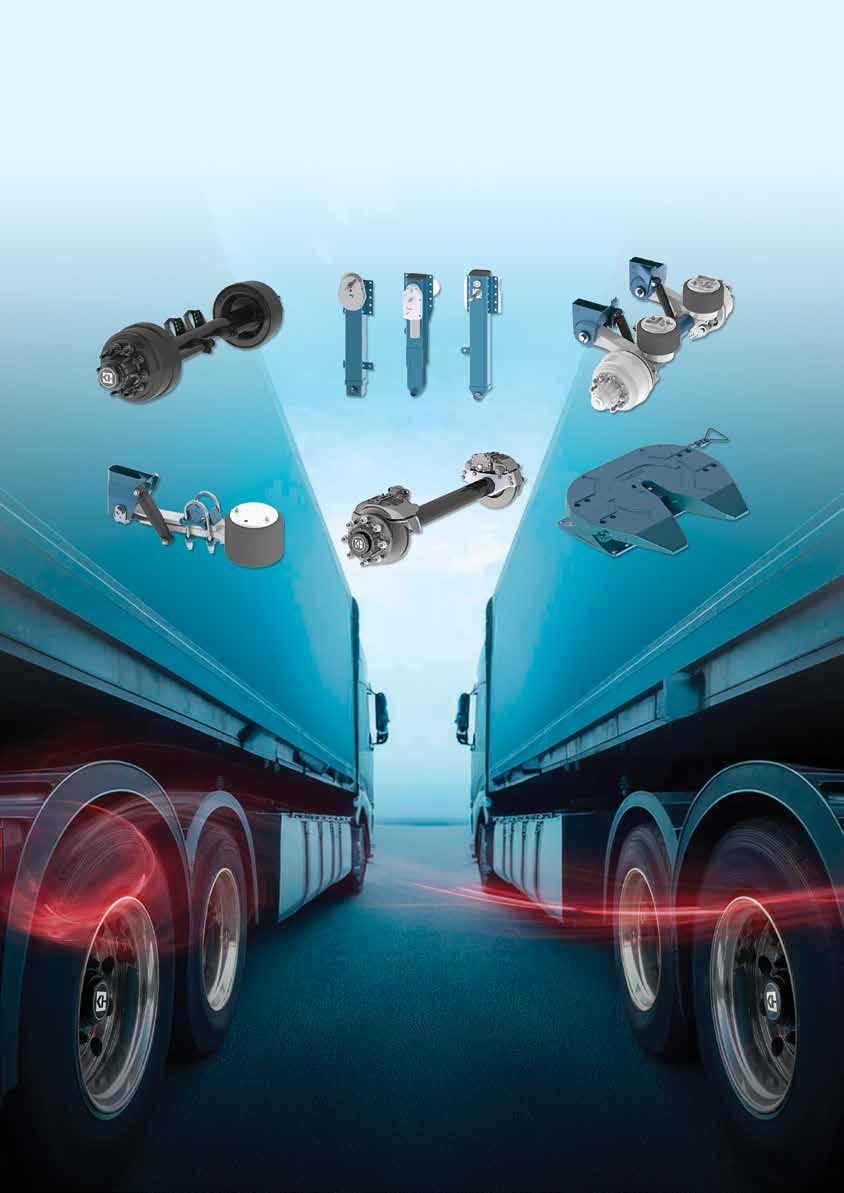


Australians are being told that our country will achieve net zero emissions by 2050 by transitioning the energy system to renewables, decarbonising and bringing emerging clean energy on stream.
The year 2025 is only 25 years away. We know that transport will be squarely in the
firing line. While innovative policy settings should not be ruled out before they emerge, as a sector that has experienced more than its fair share of warped decisions in the name of policy, we are right to be watchful, if not suspicious.
One of the suggestions for reducing emissions is that fossil fuels will be
replaced with clean energy sources such as electricity and hydrogen, notwithstanding that we currently have neither the infrastructure nor the capability. There’s a lot to achieve in 25 years.
The kicker of course is that instead of being incentivised to adopt new technology, reform will likely be achieved
The Cook Government has injected $1.2 million into developing an Advanced Biofuels Strategy to manoeuvre Western Australia into a strong position to capture new market opportunities and drive emissions reduction.
The strategy delivers on a 2025 election commitment and will help WA capitalise on its competitive advantages and attract investment in the production of renewable diesel and sustainable aviation fuel.
WA is well placed to fuel this emerging industry, with ready supplies of oat, wheat and barley stubble, as well as canola and woody biomass from mallees and blue gums.
Churchill Capital Consulting Pty Ltd (trading as SIA) will deliver the Advanced Biofuels Strategy, supported by a comprehensive economic analysis of WA’s biomass feedstocks, supply chains and technology pathways, to be provided by GHD Pty Ltd.
Stakeholder consultation for both the strategy and economic analysis will commence soon.
Advanced biofuels have an important role in the decarbonisation of mining, agriculture, transport and aviation, supporting the Cook Government's economic diversification and regional growth goals.
This initiative forms part of the Cook Government’s ambitious Made in WA Plan
through policy changes that leave little alternatives but to adopt the policy makers preferences – in other words ‘we have ways of making you conform’. This is where the discussion on fuel tax credits enters the debate with a few notable commentators suggesting that making diesel more expensive will ‘encourage’ decarbonisation.
Australia’s Fuel Tax Credit (FTC) system refunds most or all of the federal fuel excise on diesel used off-road (mining, agriculture, construction) and in certain on-road uses by heavy vehicles. Current rates refund 51.6 c/L for off-road uses and 19.2 c/L for heavy vehicles travelling on public roads, with rates indexed and adjusted by the fluctuation in the road user charge.
Several policy groups argue the FTC blunts price signals to cut diesel use and should be pared back or removed for some users. The Grattan Institute proposes abolishing credits for heavy on-road trucks and roughly halving them for off-road, saying this would better reflect environmental and health costs while improving the budget. The Australia Institute calls the FTC a fossil-fuel subsidy urging phase-out, particularly for mining. Climate Energy Finance (CEF) goes further, calling for caps with reinvestment into electrification. The Fortescue Group has publicly backed reform in principle, arguing the current settings “subsidise burning diesel.” The Greens also advocate abolishing the diesel credit for large miners as part of broader negotiations on climate policy. The Productivity Commission has recommended that the Fuel Tax Credit Scheme should be overhauled to substantially reduce the size of the tax credits flowing through to big business. The Australian Council of Trade Unions has called for the Fuel Tax Credit Scheme to be capped so that no company can claim more than $20 million a year in fuel tax
to encourage local manufacturing and value adding industries, reduce reliance on imports, promote local energy production, create skilled jobs, and increase economic diversification.
Agriculture and Food Minister Jackie Jarvis said, “Advanced biofuels are vital additions to the clean energy mix, which have potential to supply industry across our vast State with a sustainable alternative in the race to decarbonise.
“Together with WA’s abundance of biomass feedstock, it makes sense to support the development of this
Increasing the effective price of diesel will oversee a shift to alternatives if they are available, but we are some way from reliable alternatives and what does it do to the investments industry has made in its fleet?
credits but keeping it in place for smaller operators.
A broad coalition of industry groups opposes changes to the FTC scheme including the Minerals Council which leads the Fuel Tax Credit Alliance, the Australian Trucking Association and the National Farmers’ Federation. These groups warn that removing FTC would increase costs, threaten jobs and investment, and ultimately result in higher prices for goods.
Removing or cutting FTC would immediately raise fuel input costs for mining, quarrying, construction, farming and freight. Given thin margins most of the increase would be passed forward in supply chains. Higher line-haul and lastmile freight charges flow into supermarket shelves, building materials, and export supply costs. Grocery prices and regional cost-of-living pressures will increase.
The magnitude of the impact of course depends on design. Would it be full or partial removal and which sectors might successfully argue to be carved out?
There is little doubt that increasing the effective price of diesel will oversee a shift to alternatives if they are available, but we
exciting industry with a comprehensive Advanced Biofuels Strategy.
“By accessing existing resources and scaling local production, we can build domestic fuel security and drive growth of this emerging industry.
“Alongside the Australian Government’s investments to accelerate the use and supply of low carbon liquid fuels, the Advanced Biofuel Strategy will establish WA as a leader in the biofuels industry – delivering economic, environmental and community benefits in the regions.”
are some way from reliable alternatives and what does it do to the investments industry has made in its fleet?
There are real constraints to switching to alternative fuels. In long-haul road freight and broadacre agriculture, commercially ready zero-emissions options are still emerging; grid access in remote regions is limited; and electric heavy vehicles remain costly with range and charging hurdles. Abrupt removal without transition support risks a simple cost pass-through without much nearterm abatement which is why there is a suggestion that reforms should be calibrated by for example removing FTC for on-road heavy vehicles first and use the revenue to de-risk electrification through depot charging, microgrids, electric batteries, and to pilot hydrogen.
Whether removing the FTC scheme will accelerate decarbonisation depends on the policy architecture. A blunt repeal could be inflationary with limited reduction in diesel use in areas with few if any alternatives, such as in rural transport.
One thing is for sure, reducing the FTC scheme is on quite a few lips and as the clock ticks towards 2050, the noise will become louder and the desire to push industry away from diesel will become greater. Our industry has a recent experience with transition due to government policy with the phase out of the live sheep export industry and the result has been devastating for some transport companies. The transition has not been thought through with the best interests of industry in mind and genuine engagement has been lacking. Strong, vocal industry associations will be needed to argue the case against removing or reducing the fuel tax credit scheme. Another good reason to join your industry association and get behind them as they will need your support.
WA is well placed to fuel this emerging industry, with ready supplies of oat, wheat and barley stubble, as well as canola and woody biomass from mallees and blue gums

Australian Trucking Association (ATA) Chair Mark Parry and CEO Mathew Munro travelled to Perth recently to meet with trucking operators.
Mathew said that it was vitally important for the ATA to engage with trucking operators from all parts of Australia.
“As the old ABC documentary series reminded us every week, Australia is a big country. Road transport is the critical link that keeps freight moving between businesses and communities in our cities and regions, including transcontinental,” Mathew said.
“Operating conditions vary markedly with differing freight profiles, distances, climatic conditions and regulations.
“Our visit to Western Australia was an opportunity to visit depots, inspect equipment and hear about operating challenges directly from people transporting freight locally, across the state or across the nation.
“Their insights and experience greatly assist the ATA as we work with our association members to represent the trucking industry at the national level or when providing our support on priority state issues,” he said.
At the August 2025 Infrastructure and Transport Ministers’ Meeting (ITMM), ministers supported a preferred 6 per cent increase to heavy vehicle charges for 2026–27, and directed the National Transport Commission to undertake public consultation on the proposed increase.
Heavy vehicle charges are fees paid by truck and bus operators to cover extra wear and tear their vehicles cause on our roads. This helps government fund the building and maintenance of safer, more reliable roads for all Australians.
Charges are made up of:
• Annual registration charges –collected by state and territory governments
• Fuel-based road user charges –collected by the Commonwealth government
The NTC does not set heavy vehicle charges – Their role is to provide research, consultation and economic analysis to support ministers in making informed decisions.
Ministers have asked the NTC to consult with stakeholders and the
The visit program included:
• Montague Transport
• Lange Transport
• Ready Movers
• Matic Group
• Marleys Transport
• ACFS Port Logistics
Collectively, these businesses are involved in agriculture, mining, specialist OSOM, furniture removals, storage, distribution and port operations.
The ATA thanks our member associations Western Roads Federation, Australian Furniture Removers Association, NatRoad and the Australian Livestock and Rural Transporters Association for facilitating the visits.
public on the proposed increase.
To support this, they have published a consultation paper which you can download at www.ntc.gov.au/sites/ default/files/assets/files/Heavy%20 Vehicle%20Charges%20Consultation%20 2026-27_0.pdf: This provides background on heavy vehicle charges, explains the guiding principles for cost recovery and outlines how much governments spend on roads compared to what is collected through charges.
To have your say visit www. ntc.gov.au//webform/hv_ charges_2026_27?source_entity_ type=node&source_entity_id=1061and you can upload a written submission in response to the consultation paper.
Submissions close on Friday, 12 December 2025.
Following the consultation period, the NTC will analyse stakeholder feedback and relevant data to inform recommendations for Australia’s transport ministers. You can read more visit www. infrastructure.gov.au/sites/default/ files/documents/itmm-communique-11august-2025.pdf

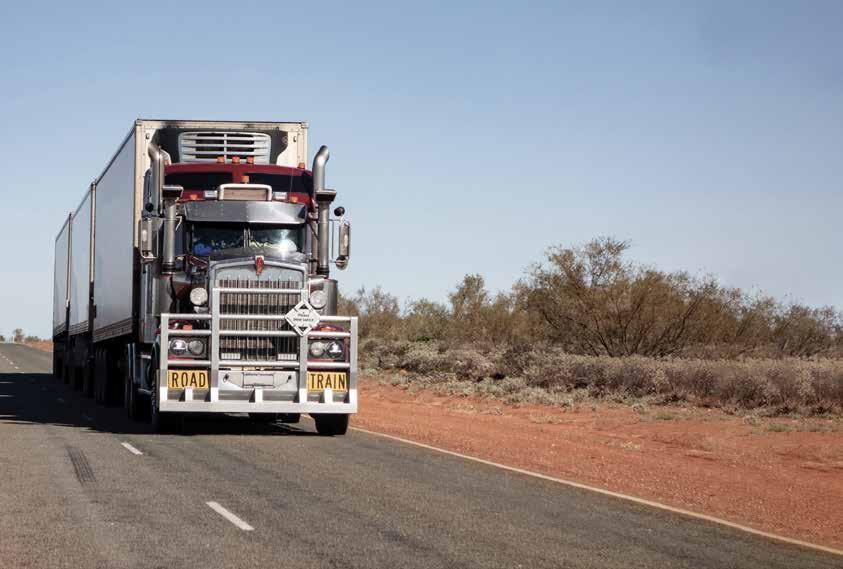

This is ‘The Outback’

By Cliff Graham
This month column comes straight after I returned from a road trip to Queensland to catch up with family and friends and it involved quite a lot of travelling with school holiday traffic and tourists in caravans.
Also, after the situation in Geraldton where trucks were fined for ‘illegally camping’ in parking areas not designated for trucks I must point out the obvious –there are camping areas set aside for heavy vehicles only but nobody polices RVs for camping there do they?
Then we have the plethora of accidents on different roads across WA, and the recent one on Indian Ocean Drive involving
foreign tourists...

I’m reminded of the ten years plus I drove trucks doing oversized loads in Queensland -some grossly oversized. Maybe not as big as compared to WA loads but fairly stressful amongst traffic on narrow roads and the amount of bridges. Some trips would involve transporting dragline boom sections or mining structural steel products some loads were up to nine metres wide and up to 60-70 metres long on steerable jinkers.
For many trips the man who would steer the steerable jinker through intersections and around corners etc would drive a vehicle ahead for the sole purpose of
reversing caravans and even vehicles driven by non-English speaking tourists back off bridges and floodway’s because they didn’t understand or obey the instructions from a pilot vehicle to pull off to the side of the road. And so many of them were unable to reverse their own caravans. All of these interactions with other road users added hours to a single trip.
My point is that there’s not too many people outside of the transport industry who recognise pilot vehicles and know what wigwag lights mean.
I’ve asked a senior police officer on one trip, “Why are there no questions when getting a license about what to do when you
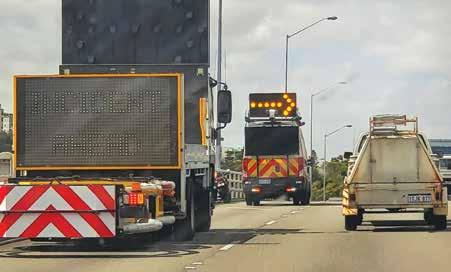
The upgrade of Kwinana Freeway has reached an important milestone with Expressions of Interest (EOI) now open for industry.
Kwinana Freeway is one of Perth’s critical transport corridors, supporting around 100,000 vehicles movements every weekday. The proposed works will ease the journey for southern suburbs’ commuters and travellers to the South West.
The $700 million upgrade will target key pinch points along Kwinana Freeway including:
• A new lane in each direction between Russell Road and Mortimer Road (increasing from two lanes to three)
• A new southbound lane between Roe
see a pilot vehicle - especially with wigwag lights flashing?”
There were calls years ago for pilot vehicles to have different coloured rotating/ flashing beacons, yet that seems to have gone into the too hard basket.
The pilot vehicle signs and lights are still the same colour as roadworks signage and flashing lights along with every other vehicle going onto a mine site who uses the samecoloured beacons. Who incidentally quite often forget to turn them off when coming back out onto roads with all the traffic.
So, no wonder the general travelling public doesn’t take notice of pilot vehicles signage or lights.
I was sitting at a red light at roadworks and there was a roadworks follow me vehicle then a wide load pilot vehicle followed by a mine spec vehicle all with their beacons flashing. Who trains or educates people to tell them apart?
One thing that really shocked me is a few months ago I was told of a driver towing a triple road train of gas tankers who pulled into a parking bay for his required rest break.
It was in the afternoon and whilst he was laying down having his rest a couple of non-English speaking tourists came into the parking bay and parked right beside the gas tanker so they could be in the shade.
Whilst the driver tried to rest, he could hear them talking amongst themselves and when his break was over, he noticed the van
was parked too close to his trailer so he went and asked them to move away a bit further. It was then he discovered that while they were laughing and chatting away in another language, enjoying themselves, they had set up a little gas cooker and were preparing a meal in the shade of his gas tanker.
Although communication barrier was a problem, he obviously had to deal with the situation and I imagine they learned some Aussie language in the process.
How many lives did they put in danger, not including themselves the driver and other people sharing the rest area? And how were they unaware by the obvious dangerous goods signage not to work it out that it was a tanker carrying flammable material?
It makes you question how many people ‘other’ than those with dangerous goods licenses know what every placard means on trucks and trailers – let alone the safe distance to stay away from them?
So, my suggestion upon hearing this
is how about having witches’ hats/safety cones with reflective red or green (however green is for non-flammable gas colour on placards but it’s different) to be placed at the entrance of the parking bay when these gas tankers pull up for a rest or change a tyre to prevent any other road users entering that particular parking bay while the gas tanker is there.
Or the witches’ hats could be used by the operator to section of a safe place around the tanker to stop other road users getting too close.
Road Safety should also include parking bays. I’m not for a second suggesting these foreign tourists shouldn’t be on the roads however, they should have some sort of education.
Highway and Berrigan Drive (increasing from four lanes to five)
• A new northbound lane from Russell Road to Beeliar Drive (increasing from three lanes to four), and
• New Coordinated Ramp Signals on northbound on-ramps between Safety Bay Road and Roe Highway, to smooth the flow of traffic on the Freeway at busy times.
Community and stakeholder engagement, utility surveys, geotechnical and environmental investigations are already underway and will provide the detail needed to inform road designs.
Construction is expected to begin in early 2027 and be completed in 2029, subject to regulatory approvals.
The Kwinana Freeway Upgrade (Roe
Highway to Safety Bay Road) is jointly funded by the Albanese and Cook Labor governments, with each contributing $350 million.
The EOI process will identify suitably qualified design and construction partners to progress to the formal tender stage. More information on the procurement process is available at www.tenders.wa.gov.au.
WA Premier and Kwinana MLA Roger Cook said, “Like so many Western Australians who live south of the Swan River, I understand how frustrating it is to be stuck in congestion along Kwinana Freeway.
“My government made a commitment during the election to make driving along the Kwinana Freeway easier - and by engaging with industry now, we're getting
People towing caravans should be at least confident enough to reverse them safely and should any drivers on our roads be in danger merely because someone else didn’t know or consider how dangerous their actions were. on with the job of fixing it.
“These upgrades will do more than just ensure everyone in Perth's south can easily use the roads they rely on to get to work or school, they will also support development of the Western Trade Coast and support my government’s Made in WA plan.”
WA Transport Minister Rita Saffioti said, “Once complete the Kwinana Freeway Upgrade project will improve road safety and ease congestion for the growing residential, commercial and industrial precincts between Perth and Rockingham.
“The Kwinana Freeway Upgrade follows the recent opening of the new ThornlieCockburn rail line and represents our ongoing investment in improving the transport network across Perth’s southern suburbs.”
Monash engineers have unveiled a breakthrough catalyst that could supercharge next-generation batteries, offering more power, longer life and lower costs.
While zinc-air batteries are currently used in small devices like hearing aids, this opens the door to rechargeable, high-power applications, moving the technology closer to real-world, grid-scale and transport uses.
Using a clever heat treatment, researchers turned a 3D material into ultra-thin carbon sheets and added individual cobalt and iron atoms, creating a catalyst that makes the battery’s oxygen reactions much faster and more efficient.
Lead authors Saeed Askari and Dr Parama Banerjee, from the Department of Chemical and Biological Engineering, said it outperformed standard commercial catalysts made from expensive metals like platinum and ruthenium.
“By engineering cobalt and iron as individual atoms on a carbon framework, we achieved record-breaking performance in zinc-air batteries, showing what is possible when catalysts are designed with atomic precision,” Mr Askari said.
“Our advanced simulations revealed that the cobalt-iron atom pairs, combined with nitrogen dopants, enhance charge transfer and optimise reaction kinetics, solving one of the biggest bottlenecks for rechargeable zinc-air batteries.”
Dr Banerjee said the principles behind this design could also be applied to other clean energy technologies including fuel cells, water splitting and CO₂ conversion.
“Running a rechargeable zinc-air battery continuously for more than two months is a milestone for the field. It demonstrates that this technology is ready to move beyond the laboratory and into practical applications,” Dr Banerjee said.
“These catalysts not only solve a key bottleneck for zinc-air batteries, but their design principles can be applied across the energy landscape – from fuel cells to water splitting – offering broad impact for clean energy.”
To read the research paper visit: doi.org/10.1016/j.cej.2025.167663
Australian business leaders are striking an optimistic tone about the coming year, despite ongoing hurdles to accessing finance, according to new research from leading credit reporting agency, CreditorWatch.
CreditorWatch’s national Business Sentiment Survey of more than 1,000 business decision makers across all industries and business sizes found strong confidence in performance, growth and working capital management. However, high interest rates and complex lending conditions are barriers to securing credit for many businesses.
Key findings include:
• 61% rated their business performance over the past year as “Good” or “Very Good” (up from 54% in 2024), with only 11% reporting poor results (down from 15% last year).
• 76% are optimistic about their growth prospects for the next 12 months (up from 72% in 2024).
• 56% reported challenges accessing finance, with high interest rates, application complexity and collateral requirements the main barriers (up from 52% in 2024).
• 80% are satisfied with their current level of working capital – a sharp rise from 69% last year.
• 60% said they had used personal funds to support working capital for their business in the past 12 months.
CreditorWatch CEO Patrick Coghlan says “The results highlight the resilience of Australian businesses and increasing
whether that’s through real-time credit monitoring, debtor management or payment forecasting.”
The 2025 survey results revealed a significant increase in the percent of businesses that reported being satisfied with their levels of working capital –
Businesses in the transport and logistics sector reported the lowest confidence, with only 43% rating their performance positively
confidence in the future, even with stubbornly tight financial conditions.
“Access to finance remains the critical bottleneck. Without easier pathways to funding, many businesses risk being held back from realising their full growth potential. Given the challenging conditions businesses have faced postCOVID, it is crucial that they are provided with as much support as possible.
“At CreditorWatch, we’re seeing strong demand for tools that give businesses confidence in who they trade with -
increasing 11 percentage points from 69% in May 2024 to 80% in September 2025.
The level of satisfaction varied by business size. Small business (2-19 employees) satisfaction increased the most, rising 14% from May 2024 (63%) to September 2025 (77%). While sole traders increased 13% (58% to 71%) in the same time frame. Medium businesses (20-199 employees) and large businesses (200+ employees) saw modest gains, increasing by 6% and 3% respectively.
Ahe Australian Government should support the trucking industry by adopting three proven solutions to reducing the industry’s carbon emissions, Australian Trucking Association CEO Mathew Munro said.
The Government released its 2035 emissions target, a 62-70 per cent reduction in Australia’s total emissions compared to 2005. The Government also released its Transport and infrastructure net zero roadmap and action plan.
Mr Munro said the climate science was no longer in dispute.
“The earth is warming. Carbon emissions are to blame. The community is calling for action: locally, nationally and internationally,” he said.
“The ATA is putting forward a strong plan to reduce the trucking industry’s carbon emissions and contribute to Australia’s climate target. Our plan would reduce emissions by 35.1 million tonnes of carbon dioxide over 25 years.
“We are very pleased that the Government’s transport roadmap recognises that increasing the uptake of high productivity freight vehicles between now and 2030 must be part of the net zero pathway for heavy vehicles.
“Australia leads the world in using advanced truck and trailer combinations, and the transport roadmap locks in a key part of our plan: increasing the use of Australia’s unique high productivity
Despite an increase in the percentage of business leaders saying they were satisfied with their levels of working capital, 60% said they had used personal funds to support working capital for the business in the past 12 months. 56% also said they continued to experience challenges when attempting to access credit.
Interestingly, it was large businesses (200+ employees) that reported the most difficulty accessing credit (76%) followed by
freight vehicles.
“In fact, the ATA’s emissions modelling shows that increasing the use of high productivity vehicles and allowing heavier zero emission trucks on more of the road network would reduce emissions by 13.3 million tonnes of carbon dioxide by 2050.
“To deliver this, we need targeted infrastructure investment, road access upgrades and a regtech solution, the National Automated Access Scheme, to reduce road permit requirements.
“The ATA has previously called for incentives to produce low carbon fuel and policies to support business to use it.
“The Government has delivered on the need for production incentives with its $1.1 billion Cleaner Fuels Program.
“The Government should put in place a low carbon fuel standard to support businesses to purchase the low carbon fuels that will be produced in Australia.
“Under the low carbon fuel standard, fuel suppliers would have to reduce the life cycle emissions intensity of the fuel they sold against declining benchmarks.
“They could meet their obligations by selling low carbon fuel or by deploying EV fast chargers or green hydrogen refuelling stations.
“Fuel suppliers would be able to spread the cost of meeting the standards across their whole customer base,” he said.
Mr Munro said the key barrier to the take up of electric trucks and other low carbon
medium businesses (20-199 employees) (72%), small businesses (2-19 employees) (50%) and sole traders (41%).
The biggest barriers to accessing credit were high interest rates (55%), complex application processes (45%) and high collateral requirements (37%).
Industry contrasts Finance and insurance businesses are the most upbeat about their prospects for the next 12 months, with 74%
technologies was the up-front capital cost.
“That’s why we need a voucher scheme to cover half the price gap between comparable low carbon and conventional technologies. It should be available for the purchase of battery electric and fuel cell hydrogen electric vehicles, hybrid vehicles, power axles, ePTOs and vehicles with H2 combustion engines,” he said.
“Our low carbon fuel standard and voucher scheme proposals are Australian versions of successful programs that are running right now in California, the world’s fourth largest economy. We know they would work.”
Mr Munro said the ATA’s plan was set out in detail in its submission to the Productivity Commission’s net zero transformation inquiry. The ATA released the submission today.
“In addition to our recommendations, the submission opposes increasing taxes and charges on Australia’s hard working trucking businesses,” he said.
“It demolishes the myth that increasing charges on road freight would result in more freight being carried on rail.
“Previous work by the Productivity Commission has demonstrated that the split of freight between road and rail would not change much even if charges on road freight increased substantially,” he said.
The ATA is a united voice for its members on trucking issues of national importance. Through its eleven member associations, the ATA represents the 60,000 businesses and 200,000 people who make up the Australian trucking industry.
To read the ATA submission visit https:// new.truck.net.au/investing-cheapercleaner-energy-zero-transform
rating performance positively and 89% optimistic about growth. Businesses in the transport and logistics sector reported the lowest confidence, with only 43% rating their performance positively.
State-by-state sentiment
Business confidence varied significantly across states/territories with Western Australia the region with lowest satisfaction in business performance and positivity about the outlook.
Residents living near the spot where 60-year-old grandfather Johnny Gray died after his 1956 Chevrolet collided with another car have raised concerns around an intersection, they say could have caused the crash.
Police Minister Reece Whitby – who described Gray’s death as a “shocking tragedy” – confirmed Main Roads WA would be conducting their own investigation into the incident, alongside WA Police.
“We do know that he was on the wrong side of the road in terms of the area where he met oncoming traffic,” he said.
“How he happened to be there, why it happened, is a subject of a police investigation, and Main Roads are obviously aware of the issue and will be doing their own investigation.
“[Main Roads] always want to have best practice and the safest roads possible, so if there’s any lessons that are to be learned, they’ll follow those up.”
One of the first on the scene of the fatal crash - James King said the Romeo Road intersection near where the incident occurred – which connects drivers to the Mitchell Freeway – could be confusing.
“I go down Romeo Road a fair bit … I think having the entry and the exit so far apart, I’m not sure if that plays a part in it,” he told 6PR.
Gray has been remembered as “a devoted husband who always put others before himself” by his wife Moana.
The Global Truck Driver Shortage Report from the International Road Transport Union (IRU) shows a deepening driver shortage crisis globally.
The 2024 results revealed a growing problem: Australia was 28,000 driving positions short in 2024, and one of the countries most affected by an ageing truck driver workforce.
The predicted global GDP growth reported will further exacerbate the problem, as higher economic output always means a higher demand for truck drivers. In Australia road freight
volumes are projected to grow by 77 percent by 2050.
NatRoad calls on all levels of government in Australia to demonstrate leadership and work together to urgently address the driver shortage crisis and improve road safety.
NatRoad has created its Road Freight Workforce Action Plan that identifies opportunities to build a skilled truck driver workforce across all states and territories. To find out more visit www.natroad.com.au/wp-content/ uploads/2025/10/IRU-Driver-ShortageCrisis-2024-results-infographic.pdf.
Australia was 28,000 driving positions short in 2024, and one of the countries most affected by an ageing truck driver workforce
Toll Transport Pty Ltd was charged with failing to provide and maintain a safe workplace and, by that failure, causing serious harm to an employee.
The company was also charged with failing to ensure that the movement and speed of vehicles and plant at the workplace were managed in a way that minimised risk to pedestrians.
In January 2021, a worker was completing the task of placing stickers on the concrete floor of the company’s Perth Airport premises to delineate bays for deliveries to different mine sites and while the worker was bending over, a forklift reversed into him, driving over his left foot and right leg and resulting in serious and permanent injuries.
WorkSafe contended that Toll did not implement practical measures to keep employees safe, resulting in an unsafe working environment and serious harm to one of its employees.
Toll pleaded guilty to causing the worker harm through its failure to provide a safe workplace and was fined $625,000 in Perth Magistrates Court.
“The company was aware of the risks
associated with the operation of forklifts in areas where interaction with other workers might occur,” WorkSafe Commissioner Sally North said.
“However, the court found that Toll’s procedures fell short in that they should have delineated the area between forklifts and pedestrians.”
North said it was “practicable” for Toll to have used barricades to separate forklifts from areas where pedestrians could be marking the ground.
“Toll did implement the use of barricades after this incident, but unfortunately too late for the worker who suffered serious and lasting injuries,” North said.
Toll, which was also ordered to pay costs of more than $8000, said it “acknowledges the outcome of proceedings” and extended its sympathies to its former employee and his family.
“The safety and wellbeing of our people is our highest priority, and we continue to undertake reviews of our safety systems and procedures, to prevent similar incidents from happening in the future,” the company told 7NEWS.com.au.

ABy LARA JENSEN
fundamental principle of safety is that those who create a hazard have the greatest opportunity for minimising the hazard and should bear the first responsibility to correct it.
This principle is widely applied in all Australian transport industries – except for the rail industry that is.
For decades, the rail industry and successive governments have deflected their responsibility to protect public safety by blaming road users for railway crashes - it’s a tried, tested and proven distraction tactic.
To give just one example, last year an Australian Government authorized advertisement that featured the wording “Almost 1000 near misses a year. Slow down. Look. Listen for trains” ran in all major newspapers. This expensive public education campaign was in response to the tragic deaths of two train drivers at a railway crossing near Bindarrah in South Australia five months earlier.
On one hand the advertisement declares an alarming safety anomaly in the staggeringly high number of 1000 near misses at railway crossings annually, before swiftly absolving the rail industry and the government from doing anything about the problem and putting the onus squarely back on the regional motorist by asking them to slow down, look and listen for trains.
This kind of brazen obfuscation raises the ire and the eyebrows of rail safety advocates like me because I am intimately familiar with the content of three national train lighting reports released in the last four years (the rail industry's own research) commissioned by the Office of the National Rail Safety Regulator (ONRSR) that have all found increased train lighting improves their visibility yet the rail industry is still not being made to comply with the findings of their own research.
While trucks are required by law to meet minimum lighting standards, there are still no mandatory visibility laws or regulations for train visibility in 2025.
And if a road user hits a train at night that is black and has no lights, staggeringly the road user is still legally at fault.
It’s baffling – and it has led me to suspect that governments are deliberately stalling action on exercising their sovereign right to amend the Rail Safety National Law to require rail operators to install flashing beacon lights and side lighting on trains and rolling stock because it would implicitly acknowledge that hundreds of road users were incorrectly assigned sole liability for crashes at regional railway crossings for decades.
Is this alone the reason why our past and current governments refuse to extend mandatory safety lighting legislation that applies to all other vehicles that travel or intersect with public roads to the rail industry?
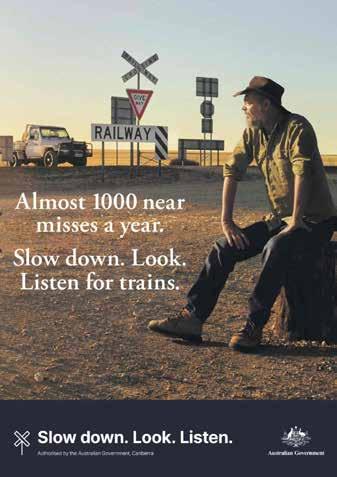
Do they view introducing this legislation not as preventing deaths in the community but rather as 'opening a can of worms' that includes the need for the government and corporates to apologize to and/or to face litigation from bereaved families like mine?
In a recent email from the Minister Assisting the Minister for Transport Hon Jessica Stojkovski to me I was extremely disappointed to read that the WA Cook Government continues to endorse the minimum and voluntary locomotive and rolling stock Australian Standard 7531 that is underpinned by the minimum, voluntary Code of Practice on Train Visibility and Level Crossings approved by all Infrastructure and Transport Ministers last year. Ms Stojkovski acknowledged in her letter to me dated 26th September that ‘rail operators have a duty to eliminate or manage risk so far as is reasonably practicable’ and acknowledged the Code ‘does not mandate flashing beacon lights on locomotives and lighting on the side of wagons.’
How on earth can the rail industry profess to be following the ONRSR directive to operate safely so far as is reasonably practicable if they consistently ignore publicly available information including coroner’s recommendations and the findings of numerous parliamentary inquiries that have all highlighted the serious public safety risks associated with poorly lit trains and rolling stock spanning more than fifty years?
West Australians need and deserve a government that acts in good faith.
We can accept well-intentioned mistakes. We can accept changes in line with changing information.
But we are left cynical and mistrustful when we see a government refuse to accept and therefore act on several decades worth of reports demonstrating that community safety is risked by having our fastest, largest and slowest-to-stop vehicles exempt from the road safety code.

By KEVIN TOOVEY
The HCVC had a double event weekend, the first stop was Gilgering on Saturday 4th October and then onto York for the annual motor show on Sunday 5th.
On Saturday we got to see a very big collection of four-wheel drive tractors, mainly Steigers and Internationals. I believe this is the largest collection of its kind in the world. It has been put together over two decades by Derrol and Sue Crane and family.
Steigers first arrived in Australia in 1976, Case IH bought Steiger tractors out in 1986 and that lime green Steiger tractor colour was retired. Apparently there was many
different shades of Steiger green, this was noticeable while walking in the museum and looking at the different Steigers side by side.
The name Steiger also disappeared for a while but now the new tractors are called Case IH Steigers and are red in colour. Some rare tractors of other brands have also found a home in the shed, for example a green Acremaster, there was only ever seven built. A Waltanna, built in Victoria, it looks like a Versatile with the same colour scheme.
To collect and restore tractors, you need space and a very big shed, this shed is 90 meters long and 22 metres wide. As we were walking through, I heard many people


not only admiring the tractors but looking at the shed and saying things like, “If I had a shed like this I could…..” .
This passion for four-wheel drive tractors is now raising money for research into Ewing Sarcoma, a rare bone cancer.
The Crane family lost their son Oliver in 2001 and they have now opened the museum in his honour “The Oliver Crane Memorial 4WD Tractor Museum”. The governor of Western Australia Chris Dawson AC APM opened the Museum and the “Oliver Crane Memorial Bone Cancer Fund Inc” in front of several hundred people that made the trip to Gilgering.





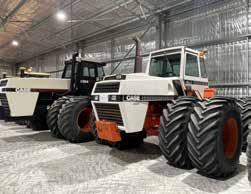


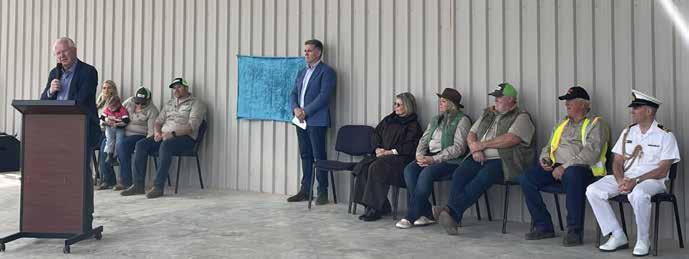
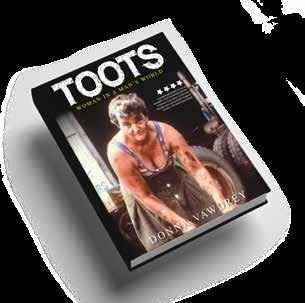
A BOOK BY DONNA VAWDREY

Follow the inspiring and at times devastating journey through Toots Holzheimer’s life. Australia’s most recognised truck driver battling non-existent roads and no telephones from the 1960s to 1990s.
• To purchase Toots’ inspiring book and merchandise visit toots-thebook.com.au •
Our thanks to Toots daughter Donna Vawdrey for allowing us to share her Mother’s story from her book - ‘Toots –Woman in a Man’s World’ each month in the magazine.
You’re a woman. You can’t do that! To Toots these words were like waving a red flag before a bull.
Pioneers had to be tough to survive in the man’s world of grease, oil and trucks and it was toughness, common sense and her willingness to get her hands dirty that gave Toots her reputation. Everybody who met her never forgot the buxom, tough, bare foot lady in the skirt and tank top, or boob tube as it was commonly called back in the sixties.
Travelling the dusty, outback roads of Cape York Peninsula in North Queensland, Toots may have pulled them out of a bog or fixed their vehicle when they broke down miles from anywhere. They may have found her underneath her truck changing a clutch plate or furiously digging herself out of a bog or just sitting beside the road doing a cross word waiting for parts or her mechanic to arrive and fix the truck. This pioneering spirit eventually brought her to the attention of the media.
This hard-working mother of eight, who drove trucks for a living, became a legend across Australia inspiring people to come and explore for themselves one of Australia’s last frontiers, Cape York Peninsula.
Standing a smidgen over five-foot (152cm) Toots embodied power, strength (physical and mental) and endurance. Toots was typical of the pioneering Aussie who made this great country what it is today.
It takes someone special, more so if you are a woman, to load a truck with 16 tons of 44-gallon fuel drums, by hand, and drive hundreds of kilometres in untamed country over roads that were little more than rough tracks.
Toots blended in with the inhospitable landscape she travelled, connecting with the people living in this remote region through her generosity and compassion.
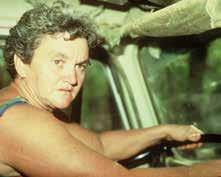
She didn’t stand on ceremony for anyone; what you saw was what you got.
When her truck got bogged, she dug herself out. Anyone who stood in her way was likely to regret it. But once the job was done, Toots easily forgave any differences and everyone shared a beer.
Toots serviced her truck, loaded her truck and slept with her truck, either in the cabin or underneath the trailer. The older Toots became the more she preferred to sleep up off the ground so she invested in a hammock that she would sling up underneath the trailer to keep the creepy crawlies out of her bed.
Toots, a lady who loved to dance and party, was living her dream-life, subservient to no man, being her own person, with no concern for the world’s opinion on the role of women in society.
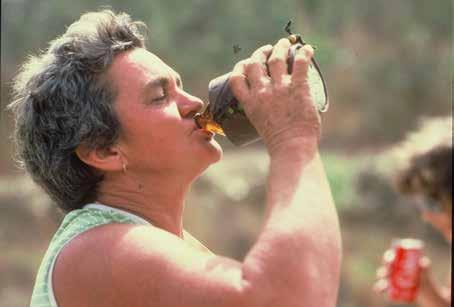



The Livestock and Rural Transport Association of Western Australia (Inc) is the only transport association in WA specifically representing rural transporters.
We are a strong voice for rural WA, ensuring that policy decisions support the viability and safety of rural transporters, primary industry and the communities they service.
Members of the Management Committee are hands on business people, most of whom would drive a truck weekly and travel on nearly every road in WA’s 150,000 km road network in the course of a year.
This close proximity between transporting operations and the advisory role means that representatives of the Association are at the coal face and as such are able to provide that all too rare practical hands on advice in committees, consultative forums and meetings.

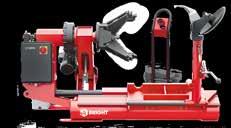


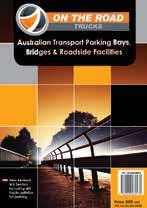

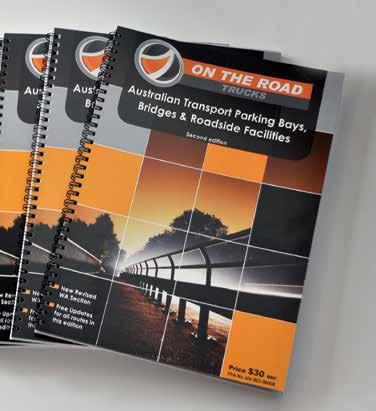



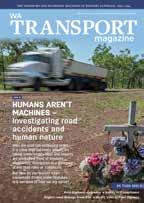
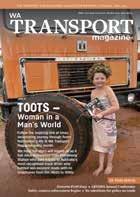
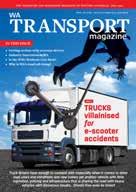


Our digital editions (11 per year) are available at ‘no cost’ and to subscribe please email karen@angrychicken.com.au
You will receive a monthly email from us and be given a link to a high quality Flip Book that you can download and access any links within the publication.
We do not make any profit on our subscriptions. Due to the rising costs of postage and producing the magazine we charge only ‘what it costs us’ to print and post your publication to you.
To receive the hard copies, please email karen@angrychicken.com.au with the following details and you will receive an invoice with EFT details:
Visit www.isubscribe.com.au/wa-transport-magazine-subscription.cfm
Note, this option costs $140 (one year) and the price includes ISUBSCRIBE fees on top of $130 base cost (printing and postage only). Thank you for your understanding and support of an independent publisher who has been producing the WA Transport Magazine for 30 years

